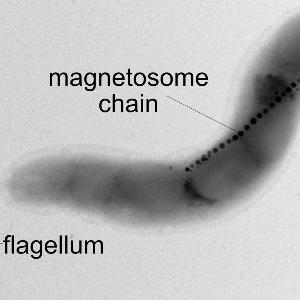Adaptations of magnetotactic bacteria to geomagnetic reversals


Life has evolved in the presence of the Earth’s magnetic field. While it is well established that many organisms use the geomagnetic field for navigation, it is entirely unknown so far how they adapt to reversals of the Earth’s magnetic dipole, and whether and how these changes may trigger evolutionary processes. The most ancient, simplest, and best studied magnetosensitive organisms are magnetotactic bacteria (MTB), which are also the only organisms for which the magnetic sensor has been unambiguously identified as highly ordered chains of intracellular magnetic crystals, the magnetosomes. These unique organelles direct the swimming motility of MTB along the geomagnetic field lines, in order to facilitate the cells' navigation towards their preferred suboxic habitats within chemically stratified aquatic sediments. Magnetosomes from MTB are thought to become preserved as magnetofossils with diagnostic palaeomagnetic properties. However, their fate after release from dead cells, the influence of predation by other organisms, and the geochemical conditions favoring magnetosome preservation are poorly understood. In this project, we propose to study microevolutionary adaptations of MTB with respect to magnetosome biomineralization and their inherent swimming polarity to simulated geomagnetic field reversals under highly controlled experimental lab conditions. Using the alphaproteobacterium Magnetospirillum gryphiswaldense as a model, we will perform a microevolution experiment by serial cultivation within vertical redox gradients superimposed with defined magnetic fields of variable intensity and directions. Spontaneous mutants which are expected to exhibit altered magnetotactic swimming behavior and polarity, and possibly, magnetosome biosynthesis, will be thoroughly analyzed at the genetic and cellular level by genome resequencing, directed deletions of identified targets, as well as by microscopic and biophysical methods to characterize their motility and magnetic properties. In addition, various previously generated mutants with different strengths and configurations of their magnetic sensors, as well as mutants with an impaired chemosensory system will be studied, to mimic different putative stages of evolutionary adaptations. In several collaborations planned within the DeepDyn priority program, these mutants along with unmodified wildtype cells of M. gryphiswaldense will also be characterized in lab-scale experiments on fossilization of magnetosomes, as well as on grazing and subsequent dissolution of magnetosomes by bacterivorous protozoa. Expected findings will not only reveal the adaptive function of magnetotaxis within the current geomagnetic field, but also help to elucidate evolutionary adaptations of ancient MTB to past variations of the geomagnetic field, and to correlate their preservation as magnetofossils with the geomagnetic field record.

Magnetic Navigation in Bacteria